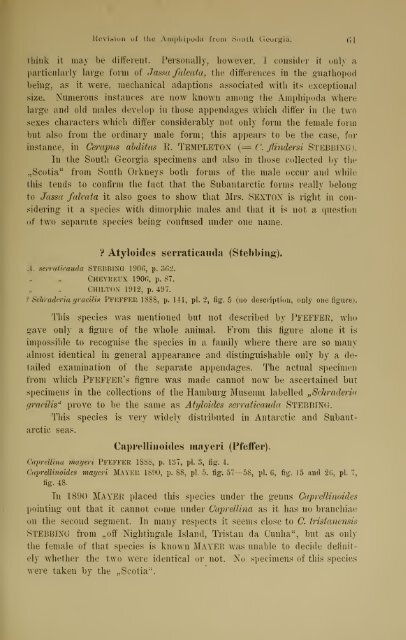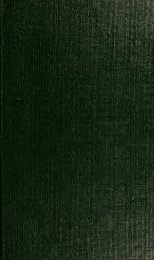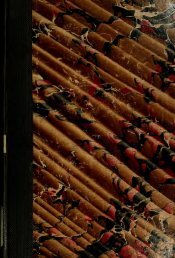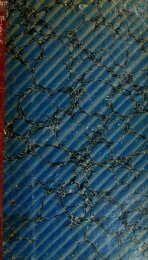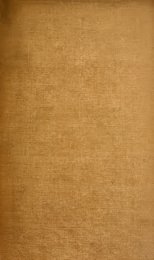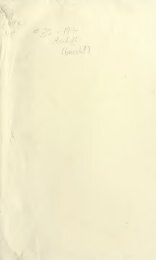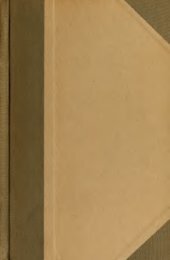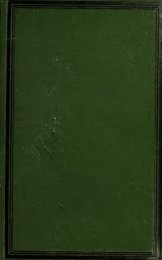- Seite 1 und 2:
MB« UOCb Hm
- Seite 3:
i( fA V (Ml' €
- Seite 9 und 10:
2. Beiheft zum Jahrbuch der Hamburg
- Seite 11 und 12:
Neue oder seltene Reptilien und Fr
- Seite 13 und 14:
Neue oder seltene Reptilien und Fr
- Seite 15 und 16:
BOULENGER, Cat. Li/... I, Neue oder
- Seite 17 und 18:
Neue oder seltene Reptilien und Fr
- Seite 19 und 20: Neue oder seltene Reptilien und Fr
- Seite 21 und 22: Neue oder seltene Reptilien und Fr
- Seite 23 und 24: Neue oder seltene Reptilion und Fr
- Seite 25 und 26: Neue oder seltene Reptilien und Fr
- Seite 27 und 28: Neue oder seltene Reptilien und Fr
- Seite 29 und 30: Neue oder seltene Reptilien und Fr
- Seite 31 und 32: Neue oder seltene Reptilien und Fr
- Seite 33 und 34: Neue oder seltene Reptilien und Fr
- Seite 35 und 36: Neue oder seltene Reptilien und Fr
- Seite 37 und 38: Neue oder seltene Reptilien und Fr
- Seite 39 und 40: Neue oder seltene Reptilien und Fr
- Seite 41 und 42: Neue oder seltene Reptilien und Fr
- Seite 43 und 44: Neue oder seltene Reptilien und Fr
- Seite 45 und 46: Neue oder seltene Reptilien und Fr
- Seite 47 und 48: Neue oder seltene Reptilien und Fr
- Seite 49 und 50: Neue oder seltene Reptilien und Fr
- Seite 51 und 52: Neue oder seltene Reptilien und Fr
- Seite 53 und 54: Neue oder seltene Reptilien und Fr
- Seite 55 und 56: V. 1911. Neue oder seltene Reptilie
- Seite 57 und 58: Neue oder seltene Reptilien und Fr
- Seite 59 und 60: Neue oder seltene Reptilien und Fr
- Seite 61: Neue oder seltene Reptilien und Fr
- Seite 64 und 65: 54 | ihas. C li i 1 ton. It seems d
- Seite 66 und 67: ;,
- Seite 68 und 69: 08 Clias. Chilton. peraeon and pleo
- Seite 73: Revision of the Amphipoda from Sout
- Seite 76 und 77: 66 G. Budde-Lund. Epistoma margine
- Seite 78 und 79: 68 G. Budde-Lund. Epimera eaudae se
- Seite 80 und 81: 70 I K Budde-Lund. Patria: Inneres
- Seite 82 und 83: 72 G. Buclde-Lund. Fig. 1. 2. 3. s.
- Seite 85 und 86: Oligochäten von Travancore und Bor
- Seite 87 und 88: Oligochäten von Travancore und Bor
- Seite 89 und 90: Oligochäten von Travancore und Bor
- Seite 91 und 92: Oligochäten von Travancore und Bor
- Seite 93 und 94: Oligochäten von Travancore und Bor
- Seite 95 und 96: Oligochäten von Travancore und Bor
- Seite 97 und 98: Oligochäten von Travaneore und Bor
- Seite 99 und 100: Oligochäten von Travancore und Bor
- Seite 101: Oligochäten von Travancore und Bor
- Seite 104 und 105: 92 W. Michaelsen. Prostaten: Drüse
- Seite 106 und 107: 94 W. Fischer. niuskelbündel sind
- Seite 108 und 109: 96 W. Fischer. Bei Sipuncuht8 discr
- Seite 110 und 111: 98 W. Fischer. Nocli habe ich betre
- Seite 112 und 113: Iqq W. Fischer. ist länger als der
- Seite 115: Über einige Sipunculiden des Natur
- Seite 118 und 119: ] ()4 F. H. Gravi 1 \. from anterio
- Seite 120 und 121:
106 F.H. Gravely. The three species
- Seite 122 und 123:
JOS F. H. Gravely. the upper and in
- Seite 124 und 125:
HO F. H. Gravely. with the other, a
- Seite 126 und 127:
U2 F. H. Gravely. Omegarius pumilio
- Seite 128 und 129:
I ]4 ( !h. Kerremans. Elle sc trouv
- Seite 130 und 131:
in; i !h. Kerremans. Hab. — Afriq
- Seite 132 und 133:
1 1 s ( 'li. Kerremans. , • finem
- Seite 134 und 135:
j _>() ( li. Kerremans. Long. 3,2;
- Seite 136 und 137:
1 22 ' 'h- Kerremans. obliques, pub
- Seite 138 und 139:
124 K- Kraepelin. die dunkle Färbu
- Seite 140 und 141:
126 K. Kraepelin. bis dahin allgeme
- Seite 142 und 143:
128 K- Kraepelin. bereits 1897 (Ann
- Seite 144 und 145:
\' ;\q K. Kraepelin. So liegen mir
- Seite 146 und 147:
132 K. Kraepelin. schiede sind. Den
- Seite 148 und 149:
[34 K. Kraepelin. Die Fundorte der
- Seite 150 und 151:
] 36 K. Kraepelin. Binden in versch
- Seite 152 und 153:
138 K. Kraepelin. Familie Chaerilid
- Seite 154 und 155:
140 K. Kraepelin. von Arten nur das
- Seite 156 und 157:
142 K- Kraepelin. a) Truncus, Cauda
- Seite 158 und 159:
1 44 K- Kraepelin. 2. Rückenplatte
- Seite 160 und 161:
146 K. Kraepelin. » der einen Abwe
- Seite 162 und 163:
]4s ? K. Kraepelin. ventral fast un
- Seite 164 und 165:
150 K- Kraepelin. Individuen der vo
- Seite 166 und 167:
] ,-> K. Kraepelin. zwei Rassen unt
- Seite 168 und 169:
154 K. Kraepelin. A) Unterhand län
- Seite 170 und 171:
iüi; K. ftraepelin. Hinterränder
- Seite 172 und 173:
158 K. Kraepelin. kreise des 6'. ha
- Seite 174 und 175:
160 K. Kraepelin. Fall kennen lerne
- Seite 176 und 177:
1 ß2 - 'v - BLraepelin. von Tavoy
- Seite 178 und 179:
1114 K. Kraepelin. doch nicht schar
- Seite 180 und 181:
ICC, K. Kraepelin. \un POCOCK aufge
- Seite 182 und 183:
lUX In.. Kraepelin. gebiet keineswe
- Seite 184 und 185:
] 70 K. Kraepelin. A) Kammzähne 22
- Seite 186 und 187:
172 K. Kracpelin. P liosoma läßt
- Seite 188 und 189:
174 K- Kracpelin. A) Die Grundreihe
- Seite 190 und 191:
1 7(> K. Kraepelin. mancherlei Zwis
- Seite 192 und 193:
1 78 K- Kr.iL'pelin. ziemlich obsol
- Seite 194 und 195:
1£0 K. Kraepelin. I. Beweglicher S
- Seite 196 und 197:
Ig2 K- Kraepelin. heraustretende K
- Seite 198 und 199:
1S4 £• Kraepelin. 2. Pfinffutus
- Seite 200 und 201:
1 s. BOEHM gesammelten ? beschrieb,
- Seite 202 und 203:
Igg K. Kraepelin. IL Pedipalpen. Vo
- Seite 204 und 205:
!
- Seite 206 und 207:
1 92 K- Kraepelin. 9. Solpuga zebri
- Seite 208 und 209:
1 ()4 K. Kraepelin. gespitzt (Fig.
- Seite 210 und 211:
196 K. Kraepelin. bei dem die Läng
- Seite 212 und 213:
] 93 Georg Duncker. unveröffentlic
- Seite 214 und 215:
200 Georg Duncker. sein. Insgesamt
- Seite 216 und 217:
202 Georg Duncker. Hieraus folgt, d
- Seite 218 und 219:
204 Georg Duncker. Eine Variationsr
- Seite 220 und 221:
206 Georg Dunckcr. Tatsächlich nun
- Seite 222 und 223:
208 Georg Duncker. von der flachere
- Seite 224 und 225:
2i() Georg Duncker. Dann ist die ha
- Seite 226 und 227:
212 Georg Dunckcr. Aus dem empirisc
- Seite 228 und 229:
2 1 4 Georg Duncker. welche zwische
- Seite 230 und 231:
216
- Seite 232 und 233:
218 I — — 2 3 teorg Duncker.
- Seite 234 und 235:
220 Georg Duncker. gruppen so versc
- Seite 236 und 237:
222 ( foorg Duncker. beide nehmen v
- Seite 238 und 239:
-)-)_[. ( reorg I >uncker. Die einz
- Seite 240 und 241:
226 Georg Duncker. Von den Regressi
- Seite 242 und 243:
928 Georg Duncker. schiedenen Grupp
- Seite 244 und 245:
2;}o Georg 1 >uncker. zahl der Afte
- Seite 246 und 247:
232 ( f©org I »uncker. Von zwei w
- Seite 248 und 249:
234 Georg Duncker. Wenn mm trotzdem
- Seite 250 und 251:
236 Georg Duncker. Sehr erhebliche
- Seite 253 und 254:
Über einige Lokalformen von Pleuro
- Seite 255 und 256:
i g 3 » Über einige Lokalformen v
- Seite 257 und 258:
linke Über einige Lokalformen von
- Seite 259 und 260:
Über einige Lokalformell von Pleur
- Seite 261 und 262:
qp P P3 ,P -p «3 C/2 1 = Über ein
- Seite 263 und 264:
Über einige Lokalformen von Pleür
- Seite 265 und 266:
Gruppe Über einige Lokalformen von
- Seite 269:
Tahrhitrli der Hnmh. Wissengeh. Ans
- Seite 275:
Über einige Lokalformen von Pleuro
- Seite 278 und 279:
256 H. Lohmann. Die allgemeine Kenn
- Seite 280 und 281:
258 H. Lohmann. Fadenziehender Schl
- Seite 282 und 283:
260 H. Lohmann. des Verbrauches, z.
- Seite 284 und 285:
262 Fig. 3. H. Lohniann. Fallstrick
- Seite 286 und 287:
264 - die teste Verbindung H. Lohma
- Seite 288 und 289:
266 H. Lehmann. daß bei der Entspa
- Seite 290 und 291:
•2
- Seite 293 und 294:
. - —. v Die von Sekretfäden geb
- Seite 295 und 296:
© Die von Sekretfäden gebildeten
- Seite 297 und 298:
Die von Sekretfaden gebildeten Fang
- Seite 299 und 300:
1 . Die von Sekretfäden gebildeten
- Seite 301 und 302:
Die von Sekretfäden gebildeten Fan
- Seite 303 und 304:
Die von Sekretfäden gebildeten Fan
- Seite 305 und 306:
Die von Sekretfäden gebildeten Fan
- Seite 307 und 308:
Die von Sekretfäden gebildeten Fan
- Seite 309 und 310:
Die von Sekrel Eäden gebildeten Fa
- Seite 311 und 312:
Die von Sekretfäden gebildeten Fan
- Seite 313 und 314:
I >ie von Sekretfäden gebildeten F
- Seite 315 und 316:
1 >ie von Sekretfällen gebildeten
- Seite 317:
Die von Sekretfäden gebildeten Fan
- Seite 321 und 322:
3. Beiheft zum Jahrbuch der Hamburg
- Seite 323 und 324:
Bericht über die in den Jahren 190
- Seite 325 und 326:
Bericht über die Untersuchungen zu
- Seite 327 und 328:
Bericht über die Untersuchungen zu
- Seite 329 und 330:
Bericht über die Untersuchungen zu
- Seite 331 und 332:
Bericht über die Untersuchungen zu
- Seite 333 und 334:
Bericht über die Untersuchungen zu
- Seite 335 und 336:
Bericht über die Untersuchungen zu
- Seite 337 und 338:
Bericht über die Untersuchungen zu
- Seite 339 und 340:
Bericht über die Untersuchungen zu
- Seite 341 und 342:
Bericht über die Untersuchungen zu
- Seite 343 und 344:
Bericht über die Untersuchungen zu
- Seite 345 und 346:
Berichl über die Untersuchungei) z
- Seite 347 und 348:
Bericht über die Untersuchungen zu
- Seite 349 und 350:
Bericht über die Untersuchungen zu
- Seite 351 und 352:
Bericht über die Untersuchungen zu
- Seite 353 und 354:
Bericht über die Untersuchungen zu
- Seite 355 und 356:
Bericht über die Untersuchungen zu
- Seite 357 und 358:
Bericht über die Untersuchungen zu
- Seite 359 und 360:
Bericht über die Untersuchungen zu
- Seite 361 und 362:
Bericht über die Untersuchungen zu
- Seite 363 und 364:
Par- Bericht über die Untersuchung
- Seite 365 und 366:
Bericht über die Untersuchungen zu
- Seite 367 und 368:
Bericht über die Untersuchungen zu
- Seite 369 und 370:
Bericht über die Untersuchungen zu
- Seite 371 und 372:
Bericht über die Untersuchungen su
- Seite 373 und 374:
Bericht über die Untersuchungen zu
- Seite 375 und 376:
Berieht über die Untersuchungen zu
- Seite 377 und 378:
Bericht über die Untersuchungen zu
- Seite 379:
Bericht über die Untersuchungen zu
- Seite 383:
Jahrbuch der Hamb. Wissensch. Ansta
- Seite 386 und 387:
QQ L. Lindinger, behaupten, daß al
- Seite 388 und 389:
62 L. Lindinger, 1909: Lindinger, L
- Seite 390 und 391:
64 L. Lindinger, Unterfamilie Cocci
- Seite 392 und 393:
Qß L. Lindingcr, 2. Abdominalsegme
- Seite 394 und 395:
(J8 L. Lindinger, Lit. : Lindinger,
- Seite 396 und 397:
70 L. Lindinger, Muansa am Viktoria
- Seite 398 und 399:
72 L. Lindinger, den P und in groß
- Seite 400 und 401:
74 L. Lindinger, - ± dreilappig ;
- Seite 402 und 403:
76 L. Lindinger, Die Tiere weichen
- Seite 404 und 405:
78 L. Lindinger, Schilde, Eier unte
- Seite 406 und 407:
80 L. Lindinger, Unterfamilie Lecan
- Seite 408 und 409:
52 L. Lindingor, Lit. : Newstead, 5
- Seite 410 und 411:
84 L. Lindinger, Gattung Pulvinaria
- Seite 412 und 413:
36 L. Lindinger, Gattung Lojihococc
- Seite 414 und 415:
88 L. Lindingcr, und über dem Hint
- Seite 416 und 417:
90 L. Lindinger, Lit. : Ne Gattung
- Seite 419:
Afrikanische Schildläuse V. 93 Coc
- Seite 422 und 423:
96 L. Lindinger, Anhang. Einige Coc
- Seite 424 und 425:
98 L. Lindinger, Durchmesser, rütl
- Seite 426 und 427:
100 L. Lindinger, Afrikanische Schi
- Seite 428 und 429:
102 P- Junge. 5. dem Botanischen In
- Seite 430 und 431:
104 p - Junge. leicht auch B. inerm
- Seite 432 und 433:
106 P. Junge. ( '. rj>/(/cios(?), C
- Seite 434 und 435:
108 P.Junge. - gedeiht, ist nicht a
- Seite 436 und 437:
110. P.Junge. Sehr bedeutend ist in
- Seite 438 und 439:
112 P. Junge. 6. Nardus stricta: a,
- Seite 440 und 441:
114 Es erscheinen von 80 Arten: in
- Seite 442 und 443:
116 P.Junge. 11. Ährchen an der Ac
- Seite 444 und 445:
118 p - Junge. 38. Beide Hüllspelz
- Seite 446 und 447:
120 P- Junge. 63. Granne in der Mit
- Seite 448 und 449:
122 p - Junge. Schlesw.-Holst. usw.
- Seite 450 und 451:
124 P- Junge. Spitze. Von den zwei
- Seite 452 und 453:
126 p - Junge. obachtet! (Knuth Fl.
- Seite 454 und 455:
128 p - Junge. — Stengel aufrecht
- Seite 456 und 457:
130 p - Junge. 1869 !), Barmbeck (J
- Seite 458 und 459:
132 P- Junge. Formen. f.pumüa nov.
- Seite 460 und 461:
134 P- Junge. Rande schwach rauh. B
- Seite 462 und 463:
136 P. Junge. Selten. — Hamburg-
- Seite 464 und 465:
138 p - Junge. Formen. 1. Dritte Hi
- Seite 466 und 467:
1 40 P- Junge. Formen. /. gracillim
- Seite 468 und 469:
14-_> P. Junge. (Ansatz zu zweiter
- Seite 470 und 471:
144 r - Junge. spelze 1,5 nun Lang,
- Seite 472 und 473:
146 P. Junge. Stengel oft mir als L
- Seite 474 und 475:
148 P- Junge. unterseits schwächer
- Seite 476 und 477:
1 50 P. Junge. und unterseits schwa
- Seite 478 und 479:
152 P. Junge. von Nolte (Novit. Fl.
- Seite 480 und 481:
154 P. Junge. in einer Zeit wie der
- Seite 482 und 483:
156 P« Junge. Hornemann gibt (Dans
- Seite 484 und 485:
158 P. Junge. 43. (sp. 9). Alopecur
- Seite 486 und 487:
lßO P- Junge. oberen Teile des Ste
- Seite 488 und 489:
16*2 P.Junge. /'. in. viviparum nov
- Seite 490 und 491:
164 p - Junge. Heiligenhafen (Nolte
- Seite 492 und 493:
166 p - Junge. 52. (adv. 34). Polyp
- Seite 494 und 495:
168 P- Junge. — Pflanze 0; Decksp
- Seite 496 und 497:
170 p - Junge. 4. Stengel 0,6— 1(
- Seite 498 und 499:
17 2 P- Junge. Als ('bergangsforni
- Seite 500 und 501:
[74 P- Junge- fläche. — Segeberg
- Seite 502 und 503:
176 p - Junge. breit, rauh. Blatth
- Seite 504 und 505:
178 P - Junge. Dazu: ,/: macrathera
- Seite 506 und 507:
180 p Jims e - - der Bestimmung von
- Seite 508 und 509:
182 p - Junge. eine Angabe, der sic
- Seite 510 und 511:
184 P.Junge. «auf den Nordfriesisc
- Seite 512 und 513:
186 p - Junge. Lauenburg: im Sachse
- Seite 514 und 515:
188 P - Junge. 70. (sp. 22). Holcus
- Seite 516 und 517:
190 P- Junge- untere 5—6, die obe
- Seite 518 und 519:
192 _/'. in. ramifera nov. f. — P
- Seite 520 und 521:
194 p - Junge. nervig. Deckspelze z
- Seite 522 und 523:
[96 P.Junge. büttel 1912!!, Eolste
- Seite 524 und 525:
198 P. Junge. kahlen Scheiden und s
- Seite 526 und 527:
200 p - Junge. einnervig, obere 4,5
- Seite 528 und 529:
202 P. Junge. 2. Ährchen bis 1,5 m
- Seite 530 und 531:
204 P - Junge. Ährchenachse behaar
- Seite 532 und 533:
206 p - Junge. glatt. Blattspreite
- Seite 534 und 535:
208 p - Jun ge. und ihrer Nebenflü
- Seite 536 und 537:
210 p - Junge. Formen. 1. Untere St
- Seite 538 und 539:
212 . p - Junge. Auf den von Sonder
- Seite 540 und 541:
214 p - Junge. Auf torfigem Boden d
- Seite 542 und 543:
216 p - Junge. 38. Gattung. Melica.
- Seite 544 und 545:
218 p - Junge. eng-, rückwärts ra
- Seite 546 und 547:
220 p - Junge. Formen. 1. var. typi
- Seite 548 und 549:
222 p - Junge. — Hüllspelzen fas
- Seite 550 und 551:
224 p - Junge. 41. Gattung;. Schism
- Seite 552 und 553:
226 p - Junge. wit/i.I. Schmidt >!!
- Seite 554 und 555:
228 P- Junge. 44. Gattung. Poa. L.
- Seite 556 und 557:
230 p - Junge. meistens 5— 6 mm l
- Seite 558 und 559:
232 P- Junge. Lübeck: Kücknitz (H
- Seite 560 und 561:
234 — P. Junge. 119. (sp. 44). Po
- Seite 562 und 563:
236 p - Junge. Nolte veröffentlich
- Seite 564 und 565:
238 P. Junge. Auf Wiesen und Trifte
- Seite 566 und 567:
240 ' P- Junge. /. straminea Rother
- Seite 568 und 569:
242 P. Junge. 3. Pflanze 0,7—1 in
- Seite 570 und 571:
244 P- Junge. besonders am Mittelne
- Seite 572 und 573:
246 p - Junge. Traube. — Auf troc
- Seite 574 und 575:
248 p - Junge. Unterseite glatt, ob
- Seite 576 und 577:
250 p - Junge. beck! sowie /wischen
- Seite 578 und 579:
252 P- Jun & e - Zu dieser Art geh
- Seite 580 und 581:
954 P- Junge. Bramstedtü. Kid mehr
- Seite 582 und 583:
256 p - Junge. bleibt die Art trotz
- Seite 584 und 585:
258 p - Junge. S t orm a 111 : Stei
- Seite 586 und 587:
200 P- Junge. spelzen bis 6,5 mm la
- Seite 588 und 589:
262 p - Junge. /. gigantea P. Junge
- Seite 590 und 591:
264 P- Junge. Mit den Eltern selten
- Seite 592 und 593:
266 p - Junge. Formen. Vom Typus we
- Seite 594 und 595:
-_Y,S P. Junge. 1. Formen. Vom Typu
- Seite 596 und 597:
270 p - Junge. bis 3 mm lang, stump
- Seite 598 und 599:
272 P- Junge. So selten. — Hambur
- Seite 600 und 601:
274 P- Junge. hoch, glatt oder unte
- Seite 602 und 603:
976 p - Junge. Formen. Die Art zerf
- Seite 604 und 605:
278 p - Junge. bürg: Stintenburger
- Seite 606 und 607:
280 P - Junge. den Nordfriesischen
- Seite 608 und 609:
282 p - Junge. — Untere Hüllspel
- Seite 610 und 611:
984 P- Junge. - spelze kürzer als
- Seite 612 und 613:
286 p - Junge. 161. (adv. 80). Brom
- Seite 614 und 615:
288 P. Junge. 164. (sp. 68). Brachy
- Seite 616 und 617:
290 — Ährchen kahl oder die Deck
- Seite 618 und 619:
. -_>()2 P. Junge. Dahme (Kausch),
- Seite 620 und 621:
. 294 p - Junge. 1. Formen. Pflanze
- Seite 622 und 623:
296 P- Junge. /. Vaillmitianum Doli
- Seite 624 und 625:
298 p - Junge. Blattfläclie 2—6
- Seite 626 und 627:
300 p - Junge. 0,2—0,6 m hoch, ka
- Seite 628 und 629:
302 p - Junge. seits einem Seitenza
- Seite 630 und 631:
304 p - Junge. Ährchen mit kürzer
- Seite 632 und 633:
306 p - Junge. wohl öfter überseh
- Seite 634 und 635:
308 p - Juu S e - SeitenährcheD ge
- Seite 636 und 637:
310 P- Ju"go- Die Pflanzen sind dur
- Seite 638 und 639:
312 p - Junge. Bordesholm, Schleswi
- Seite 640 und 641:
314 p - Junge. — Deckspelzen fast
- Seite 642 und 643:
316 P. Junge. /. laeve Ascherson a.
- Seite 644 und 645:
318 P.Junge. 195. (sp. 79). Lolium
- Seite 646 und 647:
320 p - Junge. Vom Typus weicht ab:
- Seite 648 und 649:
322 p - Junge. Holstein aufführt,
- Seite 650 und 651:
324 p - Junge Literatur. 1. Alpers,
- Seite 652 und 653:
326 P - Junge. 59. Hock E.: Branden
- Seite 654 und 655:
118.
- Seite 656 und 657:
330 p Juns e - - 168. Timm, CT.: Sc
- Seite 659:
Skizze 2.
- Seite 662:
Michaelsen, W. Lumbriciden Norddeut
- Seite 669:
*r : > » ) y ^> > \- jr J+ J h v *


